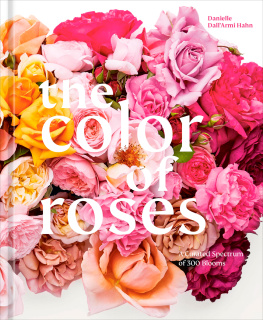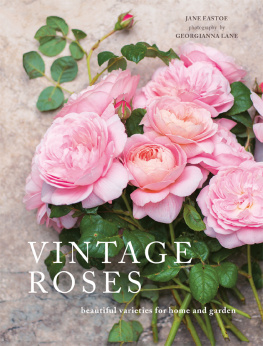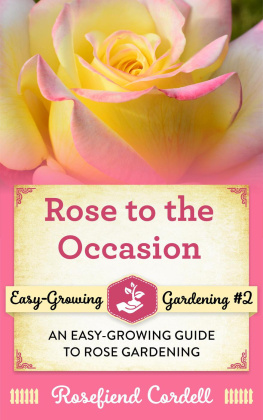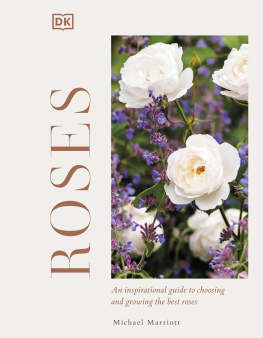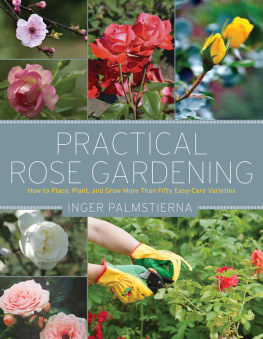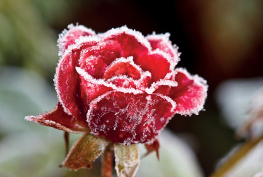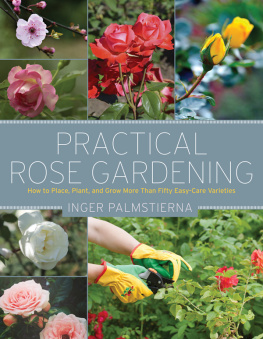10 Steps to
Beautiful Roses
Maggie Oster
CONTENTS
Introduction
Rare is the person who doesnt know and love roses. They are considered the ultimate flower to give as a gift, especially the classic red ones. Their special scent is a part of many of our perfumes. Photos or paintings of roses grace calendars, cards and advertisements. Poets and songwriters frequently use the romantic symbolism of the rose in their lyrics. For centuries, the rose has played a role in religion, art, literature and heraldry.
Rare, also, is the person who thinks roses are easy to grow. An entire mythology has sprung up about the diverse problems of insects, diseases, winterkill, special fertilizers, and complicated pruning techniques. In reality, roses are no more difficult to grow than any other shrub or flower. But just as other plants need some care and attention, so do roses. A basic understanding of these simple aspects of rose selection and care will generously reward you with the glorious blooms we all prize so highly.
More and more, people are discovering that roses can be a valuable addition to the landscape. No other shrub can bloom almost continuously from early summer until frost. And no other shrub comes in such a wide range of growing habits.
There are rose plants less than 12 inches tall that provide the same colorful addition to a yard as bedding plants, yet they need be planted only once, not every year like petunias or impatiens. There are also roses to train on fences, arbors and trellises. Other varieties are great for trailing over walls or out of hanging baskets. To say nothing of the wide range of shrub types, from spreading two-foot tall plants that might grace an entrance planting to six-foot tall, columnar roses that would make a great hedge.
Part of the reason for the current rose renaissance is that rose hyridizers have been striving to develop new varieties that are more disease resistant, better able to withstand both cold winters and hot summers, and ever more adaptable to a wide range of growing conditions. Even better, many of these recent new rose introductions also have that lovely rose fragrance.
No other plant produces the quantity or quality of blooms each year, even the same year of planting. The fresh-cut roses alone will return your purchase price many times over. No doubt, roses are one of the best gardening buys around. To insure a return on that investment, lets go through the 10 easy steps to successfully growing beautiful roses.
Step 1 Choose Well
Gertrude Stein wrote, a rose is a rose is a rose, but that just isnt the case. With thousands of varieties from which to choose, theres obviously going to be some variation in characteristics.
For instance, although roses are among the most adaptable of plants, being able to thrive in a wide range of climates from sub-tropical California to the deep-freezer climate of Alaska, some rose varieties are better adapted to certain regions than others. Also, some varieties are more disease resistant, more tolerant of neglect, and produce more flowers than others.
Theres also variation in the quality of the plants being sold, so learning to recognize healthy plants is important, too. Equally important is choosing the right plant for the right location.
To sort out this assortment of factors, lets first look at the different types, or classifications, of roses. Originally there were between 150 and 200 rose species found growing in the wild. From these have evolved the thousands available today that are divided into four major types: bush, climbing, shrubs and ground cover, and tree roses.

Bush Roses
Usually upright-growing, bush roses need no support and grow from less than six inches to over six feet tall, depending on the variety and climate. Bush roses are further subdivided into five categories: hybrid tea, floribunda, grandiflora, miniature, and heritage, or old, roses.
Hybrid tea roses are the most popular, with their classic long-stemmed, narrow buds opening into large blooms. Plants flower throughout the growing season in a wide range of colors, and they are generally three feet or more tall.
Floribunda roses were developed in the mid-1940s. Generally, they are very hardy, compact plants, growing two to three feet tall. They bear large quantities of medium-sized flowers in short-stemmed clusters all summer long. These are considered among the easiest roses to grow and are also among the best for landscaping.
Grandiflora roses usually grow five to six feet tall and bear large flowers in clusters on long stems continuously during the growing season. Because of their height, they are excellent plants for accent or for a background planting.
Miniature roses are a small version of almost every other category, but they usually grow less than two feet tall. Blooms and foliage are proportionately smaller as well. Most are extremely hardy and vigorous. They make excellent additions to the garden as edgings, mass plantings, accents or container plantings.
Heritage, or old, roses are a diverse lot of plants that were developed by plant breeders prior to 1867, a date established by the American Rose Society as a delineation between old and new roses. Most of these are direct descendants of species roses, with many varying plant and flower forms, hardiness and characteristics. Some of the heritage rose types include the Albas, Bourbons, Centifolias, Damask, Gallicas, Mosses, Noisettes and Rugosas.

Climbing Roses
Roses do not actually climb like beans or peas, but rather some kinds do have such long, flexible canes that they can readily be attached to supports like arbors, trellises, posts or fences. Just about every type of bloom and color is available in climbing roses. There are two main types of climbers: large-flowered and ramblers. Large-flowered climbers have thick, sturdy canes growing about ten feet along; plants bloom continuously or off and on throughout the summer. Ramblers have longer, thinner canes; they bear clusters of small flowers once in late spring or early summer.
Shrub and Ground Cover Roses
Growing broadly upright with slightly arching canes, most shrub roses are very hardy, low-maintenance plants. Size, depending on variety, ranges from 4 to 12 feet tall. Plants usually have many canes and lots of leaves. This makes them a good choice for hedges as well as background and mass plantings. Most rose flower types and colors are available, and plants may bloom only in the spring or throughout the season, depending on the variety. Shrub roses often produce red, orange or yellow seed pods, called hips, after blooming. These are high in vitamin C and can be used in teas and cooking or left on the plant for the birds to eat during the winter.
Ground cover roses have limber, arching canes that trail along the ground producing slightly mounded plants. There are both spring-blooming and repeat-blooming varieties.
Tree Roses
Any rose that is bud-grafted onto a straight, sturdy trunk is a tree rose. The trunk may be one to two feet tall for miniature and floribunda roses, or three to four feet tall for hybrid teas. To create a weeping effect, climbers are budded onto six-foot trunks. Tree roses require special winter protection in all but the mildest areas.


